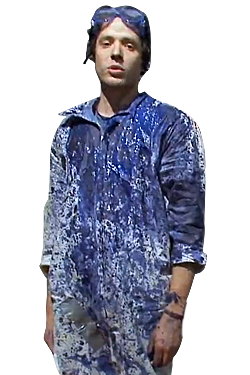
Like many of you, we’re gobsmacked by OK Go’s latest video, “This Too Shall Pass,” the band’s ode ot Reuben Lucius Goldberg. It manages to not only evoke the sheer delight of the elaborate treadmill choreography of the band’s earlier video for “Here It Goes Again,” but also encourages ridiculous amounts of repeat viewing, if only to figure out how the motherfrackin’ hell they did it. We met with OK Go’s boyishly handsome frontman Damian Kulash for a drink at the Soho Grand’s bar, where he explained that, for the band, videos are art projects onto themselves — they aren’t created to tell you more about the song. In fact, the song is chosen after they settle on the concept for the video. Kulash then enthusiastically spilled some of the secrets behind the making of “This Too Shall Pass.” But before you read on, take a first or second (or tenth) look at the three-and-a-half-minute video so you know what he’s talking about.
How did you settle on using “This Too Shall Pass” We had videos of various Rube Goldberg machines, and we’d play our songs along with them. Some were too upbeat or too slow. “This Too Shall Pass” had an anthemic quality that celebrated the machine.
Were you inspired by that (totally real) Honda Accord ad? It’s impressive and thrilling, but it’s so beautiful that you lose the element of I can’t believe it worked! The more beautiful it is, the harder it is to believe CGI wasn’t involved. My inspiration was PythagoraSwitch, a Japanese children’s show — sort of their Sesame Street. They do these crazily ingenious ten or twenty second Rube Goldberg machines — there’s a twenty minute-ish collection of a bunch of them that I’ve watched a dozen times.
How long did the video take to make, and how many people were involved? We started last August by posting an ad looking for someone to help us for a couple of months. Two days later, eighteen people applied. We couldn’t afford more than one staffer, so we split that salary up among everyone — though none of them were really in it for the money. There were a core dozen people, with about 60 on the days we were shooting. Most of them had day jobs at NASA or Jet-Propulsion Labs and came from a group now called Syyn Labs, which is composed of people who have too much creativity for their jobs or whose projects don’t fit into the academic art scene. We spent September looking for spaces; we ended up with a run-down place in Echo Park for $5,000 a month, which we had to completely overhaul. We were also working on basic design logistics, breaking the video down into six-second segments. We moved into the space in early November, and the build began later that month. We were on tour in December and the beginning of January, but the engineers worked tirelessly to get the machine to happen; they’d send us plans and videos for approval. Mid-January was spent finishing the machine. We had a couple of days of rehearsals, and then two 24-hour days of actual shooting. At the end of the video you see some of the engineers, but we were doing it in shifts so unfortunately it’s only about half of them.
Did you have rules for how to shoot it? Pages and pages of rules! The most important was no magic, no cheating. People had to see how difficult it was — you can’t fake unlikeliness. But we talked exhaustively through everything, like debating what defines magic and or how constraints make creativity.
How many takes are we talking about? Over a hundred, though roughly 62 of what we defined as a successful take — which we considered to be getting beyond the dominoes, the metal balls and what we call the Japanese table [which Kulash built with his dad], where you first see me. The hardest task was keeping the machine in time to the song — we just couldn’t screw that up.
Well, you definitely managed to bring the magic. But come clean: How much editing did you have to do afterward? We did three takes of the segment with the water descent [which occurs at 2:18 in the video], but only once did the water flow match the song. It pains me to say it but that part is edited in.
How much did the video cost? Our first video was financed by EMI and had a big-time director; the label called the shots and we got billed for over half a million dollars. Let’s just say we could have made three videos for “This Too Shall” pass for that amount of money.
Your troubles with your label, EMI, are well reported, and you started going around them early on, making your videos for a comparative pittance. They had nothing to do with your latest video, either. How did you finance it? State Farm gave us the money. They were looking for new ways to get their message out online. They took a leap of faith and let us go for it with no micromanaging. They were a lot easier to work with than a record label, and they had no issues with the video being embedded on websites. They only cared how their name would be used. [If you look closely at the little red truck that starts the video, there’s a State Farm label on the side. Go State Farm! But does that mean the future of the music industry is … insurance?]




